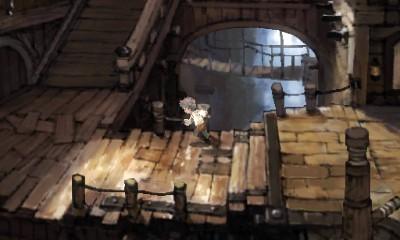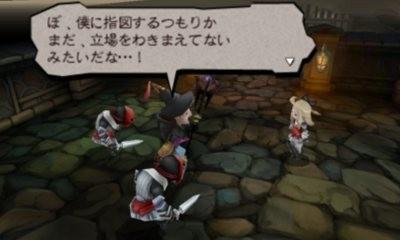Bravely Default: Flying Fairy Tokyo Game Show First Look
Announced by Square Enix before the Tokyo Game Show officially began, everybody thought that Bravely Default: Flying Fairy was a sequel to Final Fantasy: The Four Heroes of Light. It certainly looked like it, sporting an almost identical art style to the DS title.
Being on the 3DS, the machine’s successor, helped with that, too – but in the end it was an all new title being developed by some of the same people, with the brilliant Akihiko Yoshida on board to handle the character designs. Combine that with the increased power the 3DS offers over the DS, and Bravely Default looks quite pretty and lovely.

The main question I had while waiting to get my hands on the very basic demo of the title at Tokyo Game Show was how on earth they’ll localize this particular strange title for the West sadly likely won’t be answered until the game is officially announced for the West. The other major question I had – how they’ll use some of the unique features of the 3DS – has been thoroughly answered by the demo.
The short demo we could try out involved seeing how the game was going to make use of the Camera for some Augmented Reality integration into the otherwise staunchly traditional-looking RPG. The lead character is looking for an AR point to latch onto, and then the game flicks the 3DS camera on and you as the player have to point at the AR marker, which at this demo was on the floor of the booth in front of me.
When you do so, in-game stuff rises out of the AR point much as they do on Nintendo’s own AR markers with a significantly RPG and Square Enix twist – one of the lead cast members from the game appears and talks to you while ‘in’ the real world. She talks about your quest to save the world, but while she does the game has been constructed in such a way which makes her act and look as if she’s in the real world.
She’ll pace as she talks, moving back and forth around the area in relation to the AR point on the floor. Sometimes she turns away from you as she speaks, and then she’s gone, snatched away by some evil being you’ll actually have to battle in the proper game.

That was a very interesting demo, and sadly that was all there was to it. There was no gameplay or actual control of characters as such, just a chance to see an in-game cutscene demonstrated through clever use of AR. I flicked between 3D and 2D, and as with much of the AR stuff that shipped built-in on the 3DS the 3D is more striking there than just about anywhere.
If Bravely Default is as traditional as Four Heroes was it’ll be difficult for Square Enix to build some of the 3DS features like gyro into it, but with the little cutscene demonstration they’ve shown how storytelling, a huge part of any JRPG, could benefit from the 3DS cameras and AR technology. Here’s hoping there’s also alternatives for when you don’t have an AR card to hand and that the actual game itself is good.
Bravely Default: Flying Fairy is set to launch in Japan for 3DS sometime in 2012. A Western release has yet to be announced.
Announced by Square Enix before the Tokyo Game Show officially began, everybody thought that Bravely Default: Flying Fairy was a sequel to Final Fantasy: The Four Heroes of Light. It certainly looked like it, sporting an almost identical art style to the DS title.
Being on the 3DS, the machine’s successor, helped with that, too – but in the end it was an all new title being developed by some of the same people, with the brilliant Akihiko Yoshida on board to handle the character designs. Combine that with the increased power the 3DS offers over the DS, and Bravely Default looks quite pretty and lovely.
The main question I had while waiting to get my hands on the very basic demo of the title at Tokyo Game Show was how on earth they’ll localize this particular strange title for the West sadly likely won’t be answered until the game is officially announced for the West. The other major question I had – how they’ll use some of the unique features of the 3DS – has been thoroughly answered by the demo.
The short demo we could try out involved seeing how the game was going to make use of the Camera for some Augmented Reality integration into the otherwise staunchly traditional-looking RPG. The lead character is looking for an AR point to latch onto, and then the game flicks the 3DS camera on and you as the player have to point at the AR marker, which at this demo was on the floor of the booth in front of me.
When you do so, in-game stuff rises out of the AR point much as they do on Nintendo’s own AR markers with a significantly RPG and Square Enix twist – one of the lead cast members from the game appears and talks to you while ‘in’ the real world. She talks about your quest to save the world, but while she does the game has been constructed in such a way which makes her act and look as if she’s in the real world.
She’ll pace as she talks, moving back and forth around the area in relation to the AR point on the floor. Sometimes she turns away from you as she speaks, and then she’s gone, snatched away by some evil being you’ll actually have to battle in the proper game.
That was a very interesting demo, and sadly that was all there was to it. There was no gameplay or actual control of characters as such, just a chance to see an in-game cutscene demonstrated through clever use of AR. I flicked between 3D and 2D, and as with much of the AR stuff that shipped built-in on the 3DS the 3D is more striking there than just about anywhere.
If Bravely Default is as traditional as Four Heroes was it’ll be difficult for Square Enix to build some of the 3DS features like gyro into it, but with the little cutscene demonstration they’ve shown how storytelling, a huge part of any JRPG, could benefit from the 3DS cameras and AR technology. Here’s hoping there’s also alternatives for when you don’t have an AR card to hand and that the actual game itself is good.
Bravely Default: Flying Fairy is set to launch in Japan for 3DS sometime in 2012. A Western release has yet to be announced.